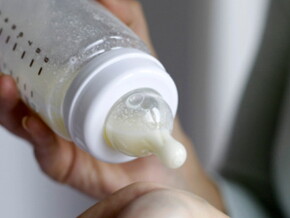
There are many reasons parents may consider introducing a formula to their baby. It’s up to you and your baby to decide when it’s a good time to stop breastfeeding. It can also be helpful to get advice from your healthcare provider or a lactation consultant before you start the switch.
Remember, supplementing with expressed breast milk or with formula does not have to mean the end of breastfeeding. If you have decided to move from breastfeeding to bottle-feeding and are wondering how to introduce a bottle, you could try offering expressed breast milk in a bottle, or breastfeed at one feeding and offer a bottle at another.
How to get a breastfed baby to take a bottle
If you’re thinking about introducing a bottle, here are some tips to make it easier for both of you.
Wait until breastfeeding is established (if you can)
Generally, it’s a good practice to breastfeed exclusively at first. Once your baby is able to breastfeed, it can make it easier for them to get the hang of using a bottle.
So, if you want to continue breastfeeding while sometimes bottle-feeding, wait until your breastfeeding is properly established first. This will help to avoid nipple confusion, which is when your baby gets more familiar with the feel of a bottle nipple and begins to have trouble latching onto your breast.
Try bottled breast milk before formula
Transitioning a baby from breastfeeding to a bottle can be a significant adjustment for little ones who have exclusively breastfed. If you’re planning to supplement with formula, offering your child bottled breast milk before jumping straight to formula-feeding may help them become accustomed to the new feeding method beforehand.
Plan ahead
If you've decided to introduce bottle-feeding for reasons such as another caregiver will be sharing the feeding responsibilities or you will be going back to work, help your little one master it by starting a few weeks beforehand. Get into the routine of giving bottles during the time of day when you’ll be away, so your baby knows what to expect, and when. This allows you both time to adjust, avoiding any last-minute panics.
Maintain your breast milk supply
If you want to keep your milk supply up, you could pump between feedings. This way, you or a caregiver can offer bottles of expressed breast milk to feed your baby when you’re not there, and continue to breastfeed in the evenings and on weekends.
Aim to pump two to three times (about every three hours) to keep your milk supply up and stay in sync with how you’d normally breastfeed. If you are back at work, check in with your employer to see what if they have any provisions in place to make pumping at work easier. Looking for more tips? See Expressing Breast Milk: Step by Step.
Practice pumping (if you’re expressing breast milk)
There are a large range of breast pumps on the market. You can choose from electric or handheld pumps and your choice may depend on how much you require or intend to use it.
Different methods of expressing and different pumping equipment may take a bit of practice. It can take a few minutes for your milk to start flowing when you express, so find a quiet place and try to relax.
Experiment and find out the best possible ways and options for yourself and your baby.
Consider combination feeding
If expressing breast milk isn’t for you, you may prefer supplementing with formula instead. This is where you offer either breast milk or formula at different feedings.
If you are away from home during the day, you may decide to offer formula during the time you are away from your baby and continue to nurse before you leave and when you get home.
Don’t forget that breast milk is produced on a supply and demand system, so if you are breastfeeding less frequently the amount of breast milk you produce may decrease.
Find the best baby formula to suit your little one
There are two main categories of infant formula for healthy term babies, depending on the baby’s age: Stage 1 and Stage 2.
Stage 1 infant formula is suitable from birth onwards.
Stage 2 infant formula is for babies over six months and has more calcium and iron to complement the diet of older babies.
There are many baby formula brands, and choosing the best baby formula for you and your child is up to you. Some contain probiotics (good bacteria that are similar to those naturally found in breast milk) or DHA, which is an important building block of baby’s brain.
Consult your healthcare provider if you need guidance. For a guide to introducing formula, see Baby Formula: Choosing, Introducing & more.
Take a gradual approach
Try offering a bottle of breast milk or formula instead of your breast at one feeding a day (maybe the one your baby is least attached to, such as mid-morning or mid-afternoon), and see how it goes.
Once you and your baby have gotten used to this, you could then think about swapping another breastfeed for a bottle-feed. This will give you both time to adjust and will reduce the chances of your breasts becoming engorged, which can be one of the signs of mastitis.
You can use expressed breast milk or formula. You should not introduce whole cow’s milk (3.25% milk fat) until your baby is between 9 and 12 months old and is eating a variety of iron-rich foods.
Pick the right time
It’s likely your baby will be more willing to try a bottle when they’re relaxed and happy. If they show you signs that they’re hungry—perhaps an hour or two after a regular feeding—you may find this is a good time to go from breast to bottle as they should be interested in feeding but not hungry enough to be frustrated or upset with using a bottle. Set aside a good amount of time to help your baby get comfortable with a bottle.
Position your baby properly
How you bottle-feed your baby is very important. Here are some tips for positioning your baby for bottle-feeding:
- Support your baby in a semi-upright position
- Support their head in the crook of your arm and hold them skin-to-skin when you can
- Hold the bottle so that the milk completely fills the nipple to ensure you baby isn’t swallowing air
- Don’t prop the bottle and don’t put your baby to bed with a bottle as these habits increase the risk of choking
Share feeding duties
Some moms find it works better if someone else gives the bottle to their baby to begin with and takes them to a different place than usual to feed. Not only does this allow you to have a bit of a break, but it provides a special opportunity for your partner or another caregiver to bond with the baby and develop an ongoing feeding relationship. Here are some tips to help rally your support system.
Experiment with different bottle nipples
There are different types of bottle nipples available, including slow-flow nipples that manufacturers claim can help when going from breast to bottle as they more closely resemble the flow of milk from the breast. If you find your baby isn’t taking to the bottle or gags when drinking, it might be worth experimenting with different nipples.
Consider using a cup
If your baby is about six months old and learning how to drink from a cup, you may not need to introduce a bottle at all. Offering breast milk or formula in a cup may help hone baby’s developing drinking skills.
Remember you’re doing great!
Introducing a bottle can be an emotional time for both you and your baby. Make time for plenty of cuddles throughout the process. Take a minute to remind yourself of the fantastic job you’ve done so far in feeding your little one and know that this is going to continue—however you choose to do it.
It’s important that you feel empowered to make informed parenting decisions, and supported and confident in your feeding choices. That way, you can focus on what matters most—spending time with your little one. So don’t forget that if you need extra help or have any health concerns as you transition, talk to your healthcare provider.
However you choose to feed your baby, remember to offer them breast milk or formula when they shows you signs of hunger, and stop when they show you that they have had enough.
Sources
Health Link BC. Feeding your baby formula: Before You Start. 2021. Feeding Your Baby Formula: Before You Start | HealthLink BC (Accessed August 2023)
American Academy of Pediatrics. Bottle Feeding Basics. 2012. https://www.healthychildren.org/English/ages-stages/baby/feeding-nutrition/Pages/Bottle-Feeding-How-Its-Done.asp
American Academy of Pediatrics. Introducing the Bottle. 2009. https://www.healthychildren.org/English/ages-stages/baby/breastfeeding/Pages/Introducing-the-Bottle.aspx (Accessed August 2023)
National Health Service. How to combine breast and bottle feeding. 2023. https://www.nhs.uk/conditions/pregnancy-and-baby/combining-breast-and-bottle/ (Accessed August 2023)
National Health Service. Milk Supply. https://www.nhs.uk/start4life/baby/breastfeeding/breastfeeding-challenges/things-that-can-affect-milk-supply/ (Accessed August 2023)





















